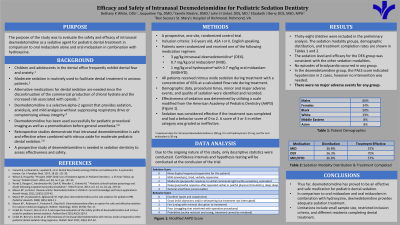Sedation
367 - Efficacy and Safety of Intranasal Dexmedetomidine for Pediatric Sedation Dentistry


Bethany White, DDS
Resident
Bon Secours - St. Mary’s Hospital of Richmond,VA
Bon Secours St. Mary's
Richmond, Virginia, United States- EB
Elizabeth Berry, DDS, MPH, MSD
Bon Secours St. Mary's Hospital
- JU
John Unkel, MD, DDS, MPA
Bon Secours St. Mary's Hospital
- EB
Elizabeth Berry, DDS
Bon Secours St. Mary's Hospital
Richmond, Virginia, United States - JU
John H. Unkel, MD, DDS
Medical Director
Bon Secours St. Mary's Hospital
Richmond, Virginia, United States
Presenting Author(s)
Co-Author(s)
Research Mentor(s)
Program Director(s)
Purpose: The aim of this study was to compare the safety and efficacy of intranasal dexmedetomidine with other sedation modalities as a sedative agent for pediatric dental treatment.
Methods: This prospective randomized blinded study recruited 38 children, 3-6 years old, who received dental treatment with moderate sedation. Three drug modalities were utilized: 1) oral midazolam with nitrous oxide sedation (MID), 2) intranasal dexmedetomidine with nitrous oxide sedation (DEX), and 3) oral midazolam and oral hydroxyzine with nitrous oxide sedation (MIDHYD). Demographics, data, vital signs, and adverse events were recorded. A standardized scale, modified from the University of Michigan Sedation Scale and the American Academy of Pediatric Dentistry, was used to evaluate the effectiveness based on sedation level and behavior respectively. Descriptive statistics were generated.
Results: The average age for the study was 4.7 years of age with 66% male and 34% female recruited. The sedation level for the DEX group was comparable with the other sedation modalities. Treatment was completed and scored effective in 57% for patients given MID, 57% for patients given MIDHYD, and 70% for patients given DEX. There were no major adverse events for any of the three groups.
Conclusions: Intranasal dexmedetomidine is a medication for pediatric sedation for dentistry that shows comparable effectiveness to other commonly used sedation modalities for pediatric dentistry.
Identify Supporting Agency and Grant Number: Research supported by Bon Secours St. Mary's Hospital.

.jpg)